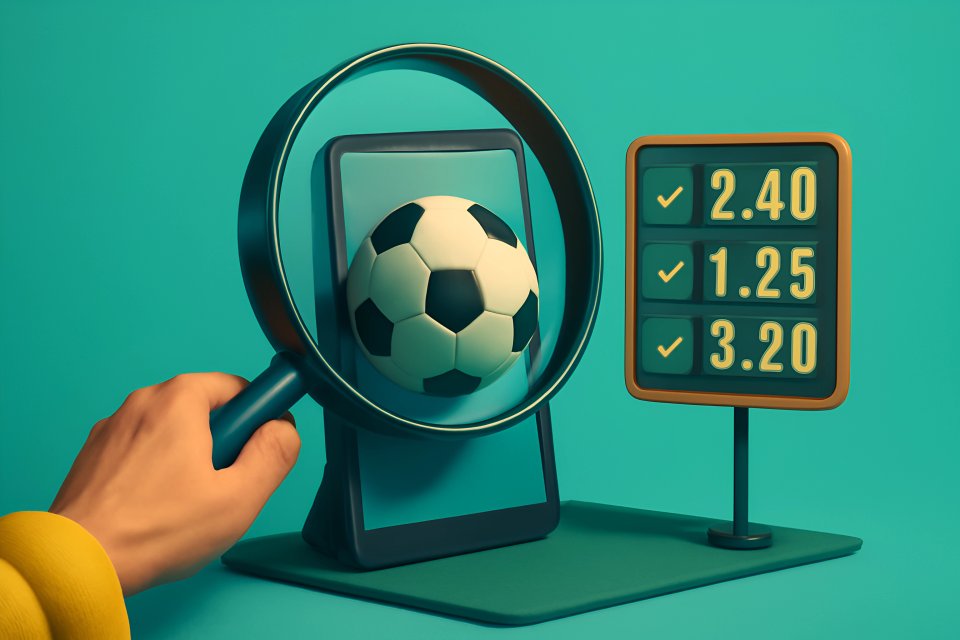
Ever stared at a sports broadcast, seen those cryptic numbers flashing next to team names, and felt a wave of confusion? You wanted to throw a few bucks on your favorite team, feel that thrill of victory, but the odds—especially those moneyline figures—felt like an alien language. You're not alone. Many casual bettors find these numbers intimidating, a barrier to entry in what should be a fun pastime. What if you could finally crack the code, understand exactly what those odds mean, and feel confident placing your bets?
This is where the fog lifts. This guide is your key to unlocking the world of moneyline odds, designed specifically for casual bettors like you. We'll strip away the jargon and complexity, revealing the simple power behind these numbers. At SportsBettinger, we believe knowledge is power, and our mission is to empower you, the everyday fan, to bet smarter, not harder. Get ready for a clear, straightforward journey into understanding moneyline odds, transforming you from a curious observer to a confident participant.
What Are Moneyline Odds? The Absolute Basics
So, what exactly are moneyline odds? Imagine the purest form of sports betting: you're simply picking a winner. That’s it. No complicated point spreads, no over/under totals to worry about. As the DraftKings Help Center explains, moneyline bets are straightforward wagers on which team will win outright. Will Team A triumph, or will Team B emerge victorious? That’s the only question a moneyline bet asks.
The core concept is beautifully simple: the odds presented by a sportsbook do two things. First, they reflect the perceived likelihood of each team winning. Second, and crucially for you, they determine how much money you stand to win if your pick is correct. This directness is precisely why moneyline betting is a fantastic starting point for anyone new to sports wagering. It’s the bedrock upon which more complex betting strategies are built, offering an accessible entry into the exciting world of sports betting.
Why is this simplicity so appealing, especially for beginners? Because it allows you to focus on what you likely already do: analyzing a game and picking who you think will win. You don't need a PhD in statistics to get started. According to Investopedia, moneyline odds are the primary format in the U.S., making them the most common type you'll encounter. This makes our moneyline betting guide an essential first read for any aspiring casual bettor looking to understand betting odds basics.
Decoding American Moneyline Odds: Favorites vs. Underdogs
Now, let's get to the heart of those numbers: American odds, the most common format you'll see in the United States. You'll notice these odds always have a plus (+) or a minus (-) sign in front of them. These little symbols are your first clue, instantly telling you who the sportsbook thinks is more likely to win and who is the long shot. It’s a simple visual cue that unlocks a wealth of information.
The Minus Sign (-): The Favorite
See a minus sign? That team is the favorite. They're the ones expected to win the contest. The number following the minus sign tells you how much money you need to wager to win $100 in profit. For example, if you see Team A listed at -150, it means you must bet $150 to win an additional $100. If your bet wins, you'll get back your $150 stake plus your $100 profit, for a total return of $250. As Pinnacle clarifies, negative numbers like -110 indicate the required stake for a $100 profit.
Consider a matchup: the Los Angeles Lakers are playing the Sacramento Kings. The odds might look like this:
- Los Angeles Lakers:
-200 - Sacramento Kings:
+180
Here, the Lakers are the favorites. A $200 bet on them would yield $100 in profit. The higher the number after the minus sign (e.g., -300, -400), the heavier the favorite, and the less profit you make relative to your stake. This is a key part of how to read moneyline odds.
The Plus Sign (+): The Underdog
Now, for the exciting part: the plus sign. This indicates the underdog – the team or player considered less likely to win. But here’s the kicker: betting on an underdog offers a greater potential reward. The number after the plus sign shows how much profit you’ll make for every $100 you bet. Using our previous example, the Sacramento Kings at +180 mean a $100 bet on them would win you $180 in profit. If they pull off the upset, you'd get back your $100 stake plus $180 profit, totaling $280.
The allure of the underdog is strong; who doesn't love a Cinderella story? And the sportsbooks reward you for taking that bigger risk. The FanDuel Sportsbook Strategy guide explains that +160 odds mean a $100 bet profits $160. This simple distinction between favorites and underdogs is fundamental to any odds explanation for beginners.
Even Money (Pick 'em)
Occasionally, you might see odds that are very close, like -110 for both teams, or even +100 (also known as "even money"). This scenario is often called a "pick 'em" or "PK." It means the sportsbook sees the matchup as very evenly balanced, with no clear favorite or underdog. A +100 odds line means you win exactly what you bet (e.g., bet $100, win $100 profit). Understanding these nuances is crucial for making informed decisions.
Visual Aid Idea: Imagine a simple graphic. On one side, a large, imposing silhouette of a "Favorite" player with "-200" next to it, and a caption: "Bet $200 to win $100 profit." On the other side, a smaller, determined silhouette of an "Underdog" player with "+180" next to it, and a caption: "Bet $100 to win $180 profit." This visual would instantly clarify the risk/reward dynamic.
How to Calculate Potential Payouts (Step-by-Step with Examples)
Alright, you understand favorites and underdogs. Now for the really satisfying part: figuring out exactly what you could win! While sportsbooks often show your potential payout when you enter a bet amount, knowing how to calculate moneyline payout yourself empowers you. It helps you manage your bankroll and truly grasp the value of a bet. The $100 standard we've discussed is just a baseline for understanding; you can, of course, bet any amount you're comfortable with.
Calculating Payouts for Favorites (- Odds)
When you're betting on a favorite (those minus odds), you're risking more to win less, relatively speaking. The simplest way to think about it for casual bettors is:
Potential Profit = (Amount Wagered / (Absolute Value of Odds / 100))
Let's break it down with examples:
- Example 1: You want to bet $50 on a team with
-150odds.- Calculation:
($50 / (150 / 100)) $50 / 1.5 = $33.33profit.- Your total return would be your $50 stake + $33.33 profit =
$83.33.
- Calculation:
- Example 2: You decide to place a $10 bet on a heavy favorite at
-200odds.- Calculation:
($10 / (200 / 100)) $10 / 2 = $5profit.- Your total return would be your $10 stake + $5 profit =
$15.
- Calculation:
Calculating Payouts for Underdogs (+ Odds)
Betting on underdogs (those plus odds) is where the potential for larger profits on smaller stakes comes in. The formula is straightforward:
Potential Profit = (Amount Wagered * (Odds / 100))
Let's see this in action:
- Example 1: You're feeling adventurous and bet $50 on an underdog with
+150odds.- Calculation:
($50 * (150 / 100)) $50 * 1.5 = $75profit.- Your total return would be your $50 stake + $75 profit =
$125.
- Calculation:
- Example 2: You place a $10 bet on a longshot underdog at
+250odds.- Calculation:
($10 * (250 / 100)) $10 * 2.5 = $25profit.- Your total return would be your $10 stake + $25 profit =
$35.
- Calculation:
It's crucial to always distinguish between your profit (the amount you've won beyond your stake) and your total return (your initial stake plus your profit). This distinction is vital for bankroll management and understanding the true outcome of your bets. Many bettors find it easier to convert American odds to decimal formats for simpler payout math, a technique William Hill explains by showing +250 American odds are equivalent to 3.50 in decimal, where payout is simply stake * decimal odds.
Understanding Implied Probability (Why It Matters, Even for Casuals)
Now, let's peel back another layer: implied probability. This might sound a bit technical, but trust me, it’s a powerful concept that can sharpen your betting instincts, even if you're just betting for fun. What is implied probability? In simple terms, it’s the sportsbook's assessment of an outcome's likelihood, converted from the odds into a percentage. Crucially, this percentage also includes the sportsbook's operational margin, often called the "vig" or "juice."
Why should a casual bettor care about this? Understanding implied probability helps you gauge the perceived risk versus reward of a bet. It allows you to compare the sportsbook's mathematical assessment with your own gut feeling or knowledge about a game. For instance, if the odds imply a team has only a 30% chance of winning, but your research (or even just your strong intuition as a fan) suggests they have a much better shot, you might have found a value bet. It helps you ask: do these odds seem "fair" based on what I know?
Here are the basic calculations, keeping it simple for understanding moneyline odds:
- For Negative Odds (-):
Implied Probability % = (Absolute Value of Odds / (Absolute Value of Odds + 100)) * 100- Example:
-150odds.(150 / (150 + 100)) * 100 = (150 / 250) * 100 = 0.60 * 100 = 60%. The sportsbook implies this team has a 60% chance of winning.
- Example:
- For Positive Odds (+):
Implied Probability % = (100 / (Odds + 100)) * 100- Example:
+150odds.(100 / (150 + 100)) * 100 = (100 / 250) * 100 = 0.40 * 100 = 40%. The sportsbook implies this team has a 40% chance of winning.
- Example:
Practical Tips for Using Moneyline Odds (For Casual Bettors)
Armed with your newfound knowledge of reading odds and calculating payouts, how can you, the casual bettor, use this to your advantage? It's not about becoming a professional gambler overnight; it's about making more informed choices and enhancing your enjoyment of the game. The goal is to feel more in control and make your entertainment budget stretch further, perhaps even snagging some satisfying wins along the way.
First, don't just blindly bet on heavy favorites. Yes, they are more likely to win, but the reward is often minuscule. Ask yourself: is risking $500 to win $100 on a -500 favorite truly worth the anxiety if an upset happens? As Action Network points out, betting on heavy favorites like those at -1000 offers low ROI and high liability. Sometimes, the potential payout simply doesn't justify the risk, even if the win seems "guaranteed."
Conversely, consider the value in underdogs. This doesn't mean betting on every long shot, but if you've done a little (casual) homework and believe an underdog has a more realistic chance than the odds suggest, it could be a spot for a small, calculated wager. The key is to relate the odds to your own game knowledge. If you follow a particular league closely and sense an upset brewing that the odds don't fully reflect, that's where your insight can shine. For example, ESPN's analysis of NHL goalie injuries shows how odds can shift 3-5% in implied probability, and understanding such factors can help you spot value.
Finally, always start small, especially while you're learning. There's no shame in placing $5 or $10 bets as you get comfortable. Focus on sports you genuinely know and enjoy. Your existing knowledge of teams, players, and even how injuries might impact a game provides valuable context that numbers alone can't offer. And, if you're looking to get the best possible price, it can be beneficial to briefly check odds across different sportsbooks, as they might offer slightly different lines on the same game.
Common Mistakes to Avoid When Betting Moneylines
Knowledge is your shield against common pitfalls. As a casual bettor dipping your toes into moneyline betting, being aware of frequent mistakes can save you frustration and, importantly, money. It’s about enjoying the thrill without falling into traps that can diminish the fun. Think of this as your "don't do" list to keep your betting experience positive.
One major error is ignoring implied probability. Even a basic understanding helps you assess if the risk you're taking aligns with the potential reward. Betting without this context is like driving without checking your mirrors. Another classic mistake is chasing losses – trying to win back money you've lost by placing bigger, often riskier, bets. This is a dangerous path that rarely ends well and can quickly turn entertainment into stress.
Be wary of betting solely on your favorite team due to bias. We all love our teams, but odds are based on probability, not passion. Sometimes, the smart bet is actually against your team, or simply avoiding the game altogether if your heart and head are in conflict. Lastly, a surprisingly common mistake is not fully understanding the payouts before placing a bet. Always be clear on what you stand to win or lose; it’s fundamental to responsible betting and managing your expectations.
Conclusion: Betting Smarter with Moneyline Knowledge
You've made it! You now possess the essential knowledge to understand what moneyline odds mean, how to read them effectively, and even how to calculate your potential payouts. Those once-confusing numbers next to team names? They're no longer a mystery. You can now look at a betting line and instantly identify the favorite, the underdog, and the story the odds are telling. This is a significant step in your journey as a sports fan and casual bettor.
This understanding empowers you. It allows you to move beyond hopeful guesses and start making more informed, even strategic, betting decisions, all while keeping it fun and casual. Remember, the goal for most casual bettors isn't to get rich quick, but to enhance the excitement of watching sports and perhaps enjoy some winning moments. Always bet for entertainment, stay within your limits, and practice responsible gambling. For more guidance on this, our Beginner’s Blueprint to Responsible Sports Betting is an excellent resource.
Ready to put your new skills to the test or learn even more? Explore more betting guides on SportsBettinger, like our piece on breaking down betting lines to identify value. If you're ready to place a wager, consider checking out our expert comparison of betting platforms. We'd love to hear your thoughts or any questions you might have in the comments below!














